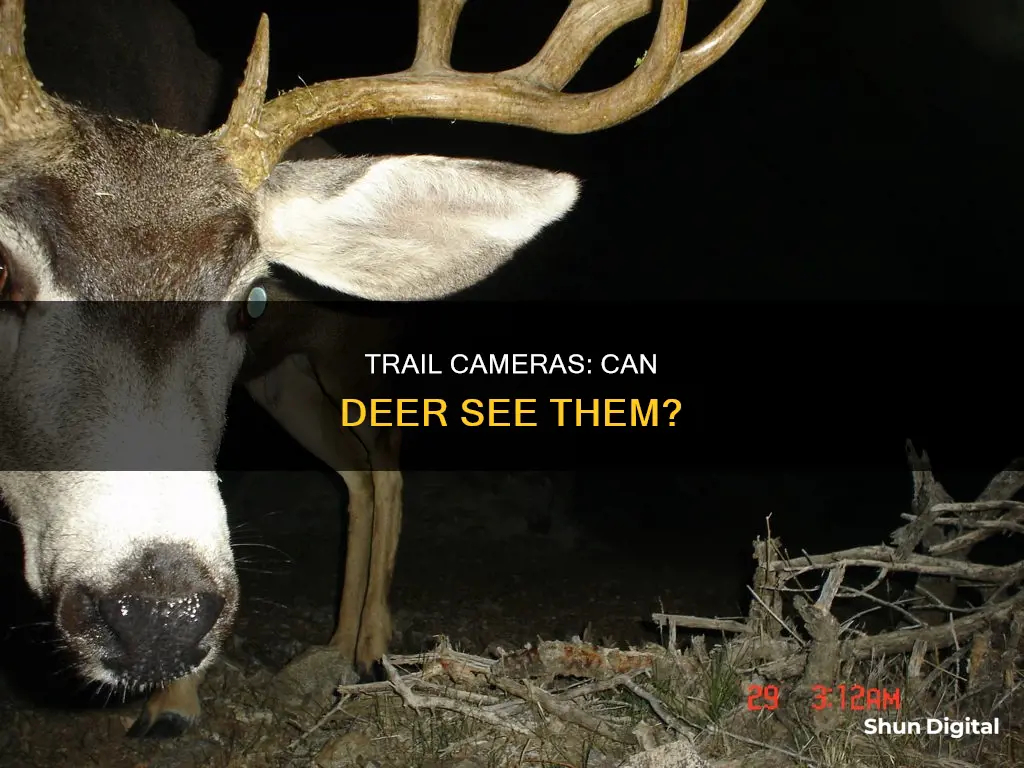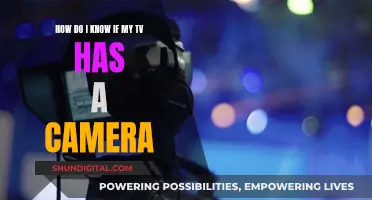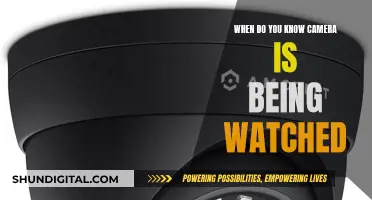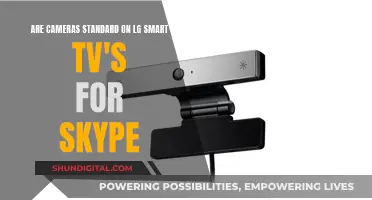
Trail cameras are a popular tool for hunters, nature enthusiasts, and those looking to monitor their property. These motion-activated devices are designed to capture images and videos of wildlife and intruders, providing valuable data and insights to users. While they can be incredibly useful, one question that often arises is whether deer, the subject of many a trail camera photo, are able to see and get spooked by these devices.
| Characteristics | Values |
|---|---|
| Vision | Deer are dichromatic, meaning they see primarily blue and green colour wavelengths (especially in low light) but do not distinguish red or orange as humans do. |
| Scent | Deer live by their sense of smell. |
| Flash | Red flash cameras tend to spook deer more than white or black flash cameras. |
| Camera Placement | Hang cameras 6-8 feet off the ground, on a multi-trunk tree or a tree with a larger diameter than the camera, and 20-25 feet away from the area of interest. |
What You'll Learn
- Deer vision: They see blue and green well, but not red or orange
- Trail camera flashes: IR, black, and white flashes all have pros and cons
- Human scent and pressure: Human scent lingers and frequent visits add pressure
- Camera placement: Height, distance, and direction all impact deer detection
- Camera type: Cell cams vs SD card cams—data transmission and costs differ

Deer vision: They see blue and green well, but not red or orange
Deer vision is dichromatic, meaning they can see two colour wavelengths. They see blues and greens very well, especially in low light, but they cannot distinguish reds or oranges as humans do. Deer eyes lack the ultraviolet light filter that humans have, so they see blues and other short-wavelength colours about 20 times better than we do.
Deer can distinguish blue from red, but not green from red or orange from red. They see blues better than humans see reds, which is notable given how well we see red-spectrum colours. They also see blues up to 20 times better than humans.
Clothing manufacturers and laundry detergent companies often add UV dyes and enhancers to their products, so clothing can take on an ultraviolet glow regardless of colour or pattern. This is important for hunters to note, as deer are especially sensitive to clothing made with reflective materials, as well as clothes washed with detergent containing UV brighteners.
Deer are also more sensitive to light in the blue spectrum during twilight hours, which is when their eyes function at their best.
In summary, deer can see blue and green well, but not red or orange.
Exploring Apple Watch: Accessing the Camera Functionality
You may want to see also

Trail camera flashes: IR, black, and white flashes all have pros and cons
When selecting a trail camera, one of the first decisions you should make is the flash mode. There are three options: no glow, low glow, and white flash. Each has its advantages and disadvantages, so choosing the right one depends on your specific needs and preferences.
No-glow flash, also known as black flash, uses 940nm infrared LEDs that emit light invisible to the human eye and most animals. The advantage of no-glow flash is that it does not emit a visible flash, making it less likely to startle wildlife or alert potential thieves. However, the downside is that no-glow flash typically has a shorter illumination range and can result in lower-quality images in complete darkness. No-glow flash is the least intrusive option but tends to be more expensive, with prices starting around $180.
Low-glow flash, also known as red glow or infrared, emits a faint red light similar to that of a smoke detector. It allows the camera to take clearer nighttime photos and has a longer flash range than no-glow flash. Low-glow flash is the most widely used and economical option. However, some believe that animals can see the red glow, which may spook them. Low-glow flash is typically around 850nm on the nanometer spectrum, which some animals, like deer and foxes, can detect if looking directly at the camera.
White flash is the same technology used in conventional cameras during low light, emitting a bright white light. This form of flash is easily seen and can startle animals. White flash can capture colour images at night and is effective for fast-moving animals. However, its potential to disturb animals makes it uncommon in modern trail cameras. White flash is often used by researchers who need to see specific markings on animals but is not ideal for deer hunters.
In summary, no-glow flash provides stealth and is suitable for hunting and security cameras, but it may result in lower-quality images. Low-glow flash offers better image quality and a longer flash range but may be more detectable to animals. White flash provides colour night-time photos and the longest flash distance but is more likely to spook animals.
Mastering Camera IQ: A Guide to Understanding Your Camera's Settings
You may want to see also

Human scent and pressure: Human scent lingers and frequent visits add pressure
Human scent lingers for far longer than you might think. Deer have an incredibly acute sense of smell, and they can tell the difference between blown-in odour and residual odour from physical contact. They can even age ground scent, knowing how old it is.
Factors such as moisture, proximity, and the type of ground you've walked on can all affect how long your scent lingers. Wet ground, for example, holds scent better than dry ground. And if you've been tramping through tall grass, your scent will be much more noticeable to deer.
Some hunters believe that rain will wash away human scent, but others disagree. One hunter describes how, despite wearing rain gear and walking through 2.5 feet of water, a doe still picked up their ground scent from hours before. Another hunter describes how deer reacted to their scent left on a tree ten days earlier, despite it having rained in the interim.
How long you should wait before returning to an area depends on the level of human interaction in the area. In places where human scent is rare, deer will react more strongly to it. In areas with more human activity, deer are more accustomed to human scent and are less likely to be alarmed by it.
Some hunters wait at least a week before returning to an area, while others believe that a good rain shower can help to wash away scent in as little as a day or two. Ultimately, it's important to be mindful of the impact that human pressure can have on deer behaviour and to try to minimise your scent as much as possible when setting up trail cameras.
Weighty Matters: TV Cameras and Their Heft
You may want to see also

Camera placement: Height, distance, and direction all impact deer detection
The height, distance, and direction of a trail camera all play a role in detecting deer movement. Here are some tips to optimise your camera placement:
Height
The ideal height for a trail camera is at the centre of the animal's body. This allows the camera's PIR detection system to detect changes in infrared radiation from the surrounding area effectively. The recommended height is around 7 to 9 feet above the ground, which is about head high for most people. This height reduces the chances of the camera being noticed, smelled, or avoided by deer. Hanging the camera higher than the animal's height can also keep it out of sight, but it's important to consider the detection angle and adjust the camera's tilt accordingly.
Distance
When placing a trail camera, it is recommended to maintain a distance of 25 to 35 feet from the anticipated animal path. This distance provides the optimal balance between capturing clear images and minimising the impact on the deer's behaviour. However, it's important to consider the detection distance and interpolation settings of your specific trail camera, as these factors may alter the ideal distance.
Direction
The best direction to hang your trail camera is directly perpendicular to the animal's expected path of travel. This perpendicular angle allows the PIR sensor to detect changes in infrared radiation more precisely, resulting in fewer missed triggers. Additionally, if your camera has a slower trigger speed, you can angle it slightly towards the path to increase the time the animal remains within the field of view, improving the chances of capturing a photo.
Apple Watch Series 5: Camera Expectations Explained
You may want to see also

Camera type: Cell cams vs SD card cams—data transmission and costs differ
When choosing a trail camera, one of the key considerations is whether to opt for a cell cam or an SD card cam. Both have their advantages and disadvantages, and the right choice depends on your specific needs and preferences.
Cell Cams
Cell cams, or cellular trail cameras, offer several benefits that make them a popular choice for hunters and wildlife enthusiasts. One of the biggest advantages is their ability to transmit images wirelessly over a cellular network, eliminating the need to physically retrieve the camera or SD card to view photos. This feature is especially useful for cameras placed in remote or hard-to-reach locations. Cell cams also allow for remote control of camera settings and the ability to switch between photo and video modes, adjust sensitivity, and check battery levels via a smartphone app.
However, there are some drawbacks to consider. Cell cams typically require a monthly or annual data plan, which adds to the overall cost of ownership. Additionally, there may be legal restrictions on the use of wirelessly connected cameras, so it's important to check your state's regulations before purchasing.
SD Card Cams
SD card cams, on the other hand, do not require a cellular connection or data plan, which can save you money in the long run. They are also generally simpler to operate and may be more suitable for those who prefer a more hands-on approach to camera management.
The main disadvantage of SD card cams is the need to physically access the camera to retrieve the SD card and view the captured images. This can be inconvenient, especially if the camera is located in a remote area. Additionally, SD cards can become corrupted, leading to potential data loss if the images are not transferred promptly.
Both cell cams and SD card cams have their pros and cons. Cell cams offer the convenience of wireless image transmission and remote control but come with the added expense of a data plan. SD card cams are generally more cost-effective and straightforward but require manual retrieval of the SD card. Ultimately, the decision between cell cams and SD card cams depends on your specific needs, budget, and preferences for camera management.
The Camera on Your TV: Should You Be Concerned?
You may want to see also
Frequently asked questions
Deer can see some trail cameras. They can see red and white flash cameras, but not black flash cameras, which use a wavelength of light outside of the UV spectrum that deer are able to detect.
Deer are dichromatic, meaning they can see two colour wavelengths. They see blue and green very well, especially in low light, but they don't see red or orange as humans do.
There are several ways to avoid spooking deer with a trail camera. Place the camera 6-8 feet off the ground, on a tree that is thicker than the camera, and 20-25 feet away from the area of interest. Avoid using a strap to hang the camera, as these are visible and can hold scents.







